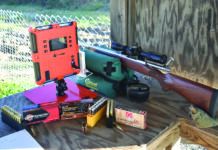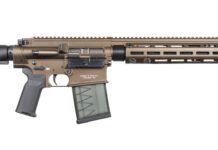Looking for a go-anywhere do-anything 308 Winchester-chambered rifle? If so, in this article we test Remington SPS bolt guns in two variants, a Tactical version with a carbine-length barrel at 16.5 inches and the 26-inch barrel SPS Varmint, to get a good look at opposite ends of the length spectrum. Then we added two rifles with more traditional barrel lengths, the 22-inch-barrel Savage Axis and a semi-auto, the Browning Automatic Rifle Stalker, also with a 22-inch tube.
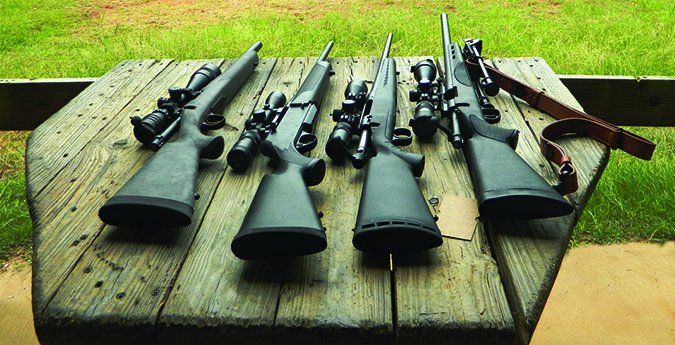
The truth is, these rifles will fire most of their cartridges on a range. This means we’d like them to be comfortable to shoot and deliver satisfying accuracy. Hunting is a consideration, of course, so the rifle should be useful for thin-skinned game to 200 yards or more. The adage of “200-pound game at 200 yards” will apply here. In a dangerous world in which it may be the only self-defense option for some homes, the rifle should also have some utility as an emergency rifle or for area defense. It should handle quickly enough for boar hunting, or varmints and pests, such as coyotes if need be. Area defense simply means that those of us with a larger homestead or a potential campsite do not wish to be helpless if we encounter adversaries. And we’d prefer our choice not cost as much as a Scout.
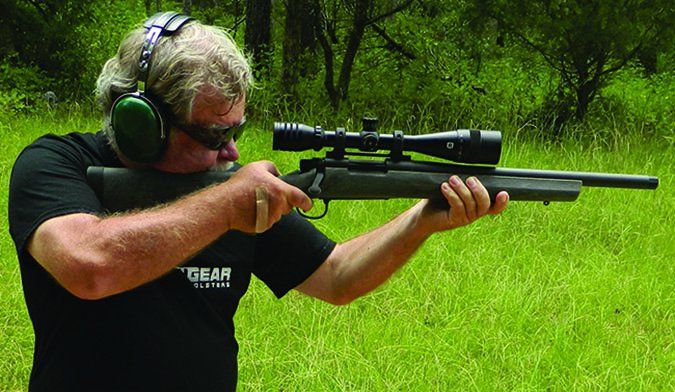
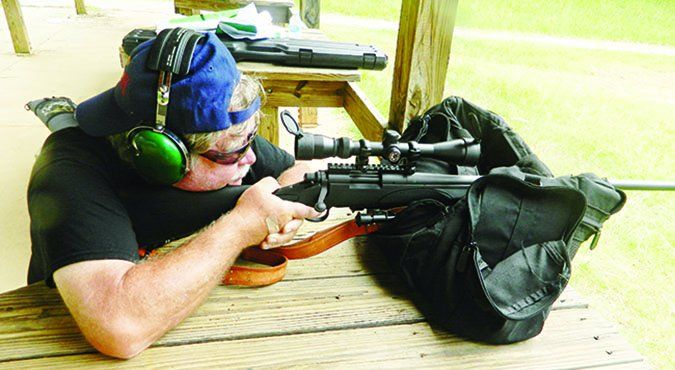
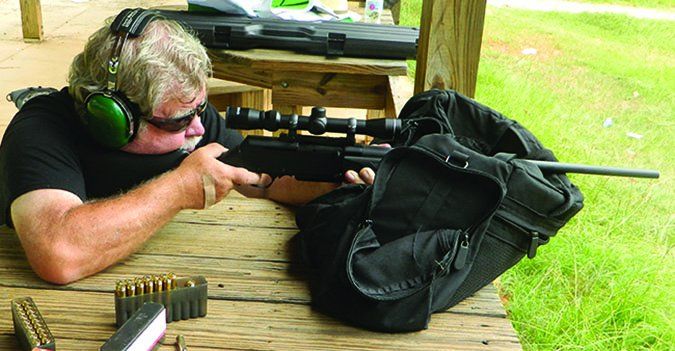
Obviously, then, we want a dependable, easy-to-shoot, easy-to-carry rifle that’s well made. Doesn’t sound that hard because we are not expecting to be able to light a match with each round, but we do want to hit the K zone at 200 yards. Some shooters have claimed that shorter, stiffer barrels like that on the Tactical shoot as well as a longer barrel, like that on the Varmint. We are going to see how velocity varies as well, and to compare the chronograph stats bolt guns develop in terms of velocity to that of a semi-auto. We do not want a 4-foot-long 12-pound rifle, but we wondered if we would have to compromise on weight (that is, go heavier) if we do not get the accuracy we want. We are not holding out for accuracy for 50 continuous shots and do not need a heavy target barrel, but, instead, we’re looking for a rifle capable of delivering good accuracy for a dozen shots or so. Durability and quality are important. The rifle should last for the shooter’s entire life. Also, to save money, we looked for used rifles in Like New or better shape, a standard which all four members of the quartet met.
We elected to fire the rifles in four drills. We would fire quickly at human-silhouette targets at 25 yards, for the SHTF situation. It is also a drill that has some merit in learning to snap-shoot predators and coyote. At 50 yards, we used the Innovative Targets (Innovative Targets.net) steel gong. While we fired for precision, we also wished to test speed to an extent in this drill and fired a combination of standing and kneeling. We would expend 20 rounds in each pursuit, at 25 and 50 yards, for 40 rounds. We also fired 10 rounds at 100 yards offhand. Finally, we fired three three-shot groups for accuracy at 100 yards with three different loads, alternating between rifles to let the barrels cool, firing from a solid rest and attempting to obtain the best accuracy possible. During the offhand firing stages, we used Fiocchi 150-grain FMJs for the 25- and 50-yard work. For firing offhand at 100 yards, we used a handload consisting of the Hornady 155-grain SST and Varget powder for 2750 fps. For benchrest accuracy testing, we used three loads. The Hornady 168-grain ELD Match, Federal 165-grain Trophy Bonded, and Gorilla Ammunition’s 175-grain Sierra MatchKing load. Here’s how they performed.
.308 Winchester Range Data
| Hornady ELD Match 168-gr. Polymer Tip | Savage Axis | Remington SPS Varmint | Remington SPS Tactical | Browning BAR MK3 |
| Average velocity | 2600 fps | 2676 fps | 2475 fps | 2580 fps |
| Muzzle energy | 2521 ft.-lbs. | 2670 ft.-lbs. | 2284 ft.-lbs. | 2482 ft.-lbs. |
| Small group | 1.9 in. | 0.6 in. | 1.2 in. | 1.3 in. |
| Large group | 2.6 in. | 1.2 in. | 1.6 in. | 1.8 in. |
| Average group | 2.3 in. | 0.9 in. | 1.4 in. | 1.5 in. |
| Federal Trophy Bonded 165-gr. Polymer Tip | ||||
| Average velocity | 2559 fps | 2744 fps | 2519 fps | 2650 fps |
| Muzzle energy | 2398 ft.-lbs. | 2758 ft.-lbs. | 2324 ft.-lbs. | 2572 ft.-lbs. |
| Small group | 1.8 in. | 0.9 in. | 1.6 in. | 1.5 in. |
| Large group | 2.6 in. | 1.3 in. | 2.2 in. | 1.9 in. |
| Average group | 2.2 in. | 1.0 in. | 1.9 in. | 1.7 in. |
| Gorilla Ammunition 175-gr. Sierra MatchKing | ||||
| Average velocity | 2500 fps | 2614 fps | 2338 fps | 2459 fps |
| Muzzle energy | 2428 ft.-lbs. | 2654 ft.-lbs. | 2123 ft.-lbs. | 2349 ft.-lbs. |
| Small group | 1.6 in. | 0.6 in. | 0.9 in. | 1.3 in. |
| Large group | 2.3 in. | 1.2 in. | 1.4 in. | 2.0 in. |
| Average group | 1.9 in. | 0.9 in. | 1.2 in. | 1.6 in. |
| To collect accuracy data, we fired three three-shot groups off a benchrest. Distance: 100 yards. We recorded muzzle velocity with a Competition Electronics Chrony Chronograph. Ammunition sources: Hornady 168-gr. Polymer Tip ELD Match 80966 ($36/20 at CheaperThanDirt.com); Gorilla Ammunition 175-gr. Sierra MatchKing GA308175SMK ($34/20 GorillaAmmunition.com); Federal 165-gr. Polymer Tip Trophy Bonded P308TT2, ($38/20 at CheaperThanDirt.com). |
||||
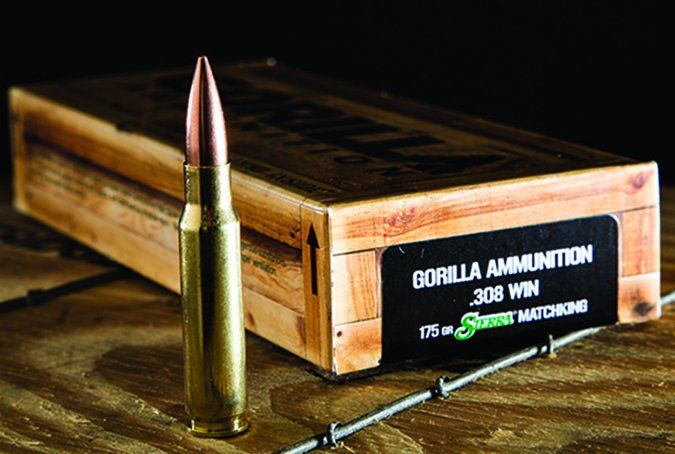
All the cartridges tested gave good-enough results as far as baseline expectations, we thought. That is, we had no failures to feed, fire, or eject in the test. And all three produced a level of accuracy we want to see—1 minute of angle, or 1-inch groups at 100 yards—in at least one rifle. For example, the Gorilla Ammunition 175-grain rounds gave the best results in the Remington SPS Varmint at an eye-popping 0.9-inch average group size, then the SPS Tactical at 1.2 inches, the BAR Stalker semi-auto at 1.6 inches, and the Savage at 1.9 inches on average, far behind the leader. We saw the same pattern with the Hornady ELD Match 168-grain Polymer Tip load, with the Varmint again shooting under MOA with a 0.9-inch average group, the Tactical at 1.4 inches, the MK3 BAR at 1.5 inches, and the Axis coming in at 2.3 inches.
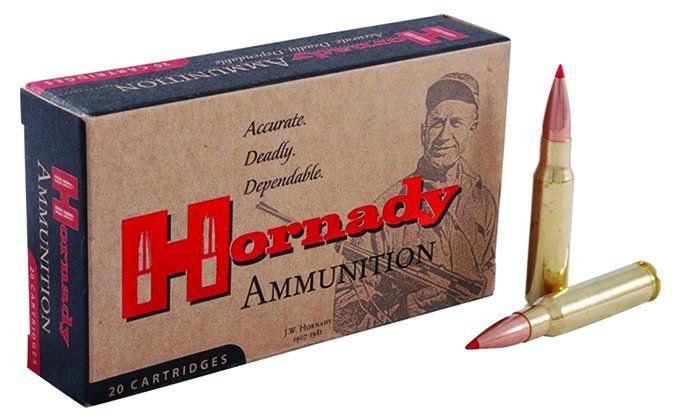
Likewise, the SPS Varmint lead the parade with the Federal Trophy Bonded 165-grain Polymer Tip load, shooting 1.0-inch average groups. The BAR jumped into second place with this load, shooting slightly better at 1.7 inches than the Tactical’s 1.9-inch average. The Axis was fourth again with an average group size of 2.2 inches.
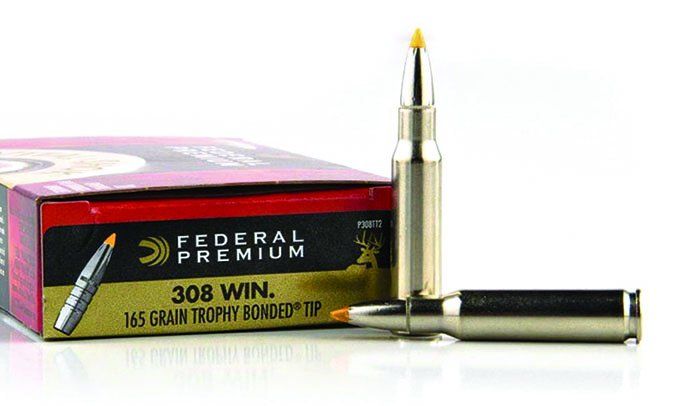
As far as velocity and the resulting energy comparisons across different barrel lengths with the Hornady ELD Match, the highest velocities and energies , not surprisingly, came from the SPS Varmint with a 26-inch-long barrel, 2676 fps and 2670 foot-pounds, respectively. The Savage was next at 2600 fps/2521 foot-pounds, followed by the BAR at 2580 fps/2482 foot-pounds, and the Tactical bringing up the rear at 2475 fps/2284 foot-pounds energy. The pattern varied slightly with the Federal Trophy Bonded 165-grain Polymer Tip rounds, with the Varmint in first (2744 fps/2758 foot-pounds), the BAR in second (2650 fps/2572 foot-pounds), then the Axis (2559 fps/2398 foot-pounds) and the Tactical (2519 fps/2324 foot-pounds). The Varmint again led the way with the Gorilla Ammunition 175-grain Sierra MatchKing, running 2614 fps/2654 foot-pounds, followed by the Axis (2500 fps/2426 foot-pounds), the Browning (2459 fps/2349 foot-pounds), and the Tactical (2338 fps/2123 foot-pounds). Beyond these objective data, here’s how each rifle performed in the eyes of our shooters.
Savage Axis 19223 308 Winchester, $240
GUN TESTS GRADE: C
The Savage Axis put in a good showing, we felt. The rifle was smooth enough, and we like the safety location, and the detachable magazine was easy to use. Accuracy wasn’t the best of the test, but the accuracy exhibited would be adequate for some chores. The rifle was dogged by a heavy trigger that we chose to fix.

| ACTION | Bolt |
| OVERALL LENGTH | 43.9 in. |
| BARREL | Matte-blued steel; 22 in. long; 1:10 twist |
| OVERALL HEIGHT w/ SCOPE | 7 in. |
| LENGTH OF PULL | 13.3 in. |
| WEIGHT UNLOADED | 6.5 lbs. |
| WEIGHT SCOPED (empty) | 8.2 lbs. |
| WEIGHT SCOPED (loaded) | 8.4 lbs. |
| CAPACITY | 3+1 |
| ACTION FINISH | Matte-blued steel |
| MAGAZINE TYPE | Detachable box |
| STOCK | Matte-black synthetic |
| TRIGGER PULL WEIGHT | 4 lbs. (adjusted) |
| WARRANTY | 1 year |
| TELEPHONE | (413) 568-7001 |
| WEBSITE | SavageArms.com |
| MADE IN | USA |

A Savage Axis combo has recently been listed at CheaperThanDirt.com at $432.18 with a Nikon scope. We found this rifle used, including a Bushnell 3×9-40mm scope and a bipod, for the bargain price listed above, in Like New condition. The previous owner had mounted the bipod for the legs to fold forward.
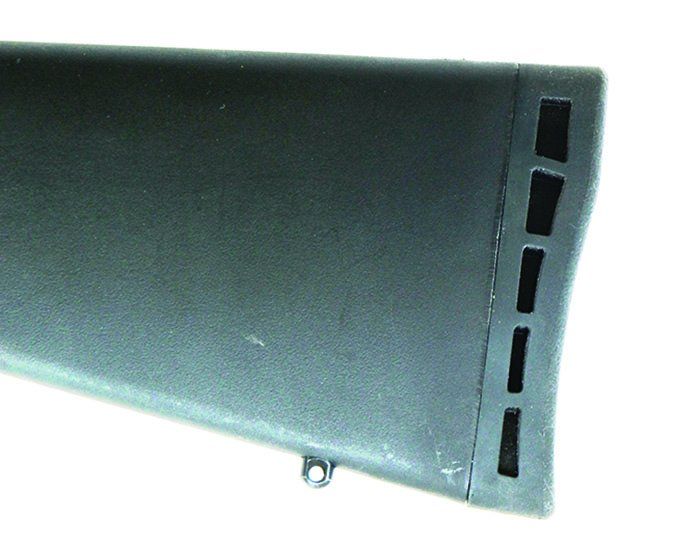
Fit of the synthetic stock to the action was good, even very good. The action is smooth enough. The Axis features a detachable three-shot magazine. The barrel is 22 inches long. The stock is a little thin in the wrist, almost wasp waisted, but this did not cause any problems when firing. The treatment of the stock gives good purchase for the hand. The forward stock treatment also gives plenty of adhesion when firing. The rifle weighs 8.4 pounds as tested, 6.5 pounds without optics or a bipod, according to Savage. This is some extra poundage. We examined the bipod mounted to the rifle and could not find a brand or name marking, although it was serialized. It isn’t an expensive bipod. Leapers or Barska bipods resemble it. We think it was worth about $50. We eventually removed it for the test.
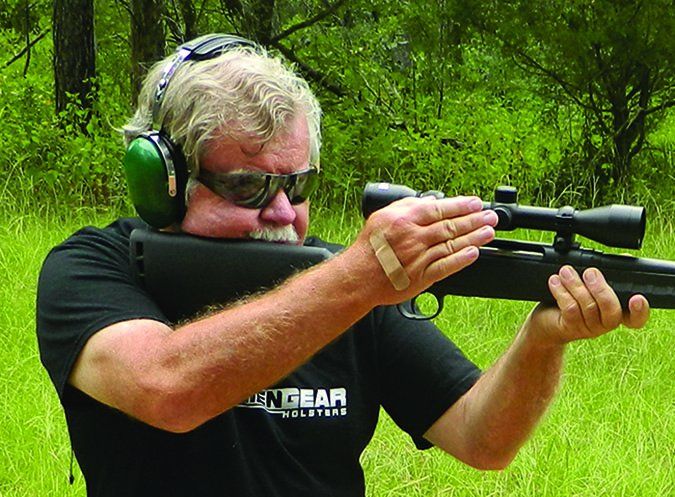
In firing the rifle at 25 yards, we noticed the Savage came to the shoulder quickly. The Fiocchi ammunition fed smoothly, as expected, so ammunition performance was not a worry. The rifle was fast enough in addressing targets. We really liked the tang-mounted safety and rated it faster to manipulate than the other rifles. The thin stock turned out to offer good speed and ease of returning to firing position after working the bolt.
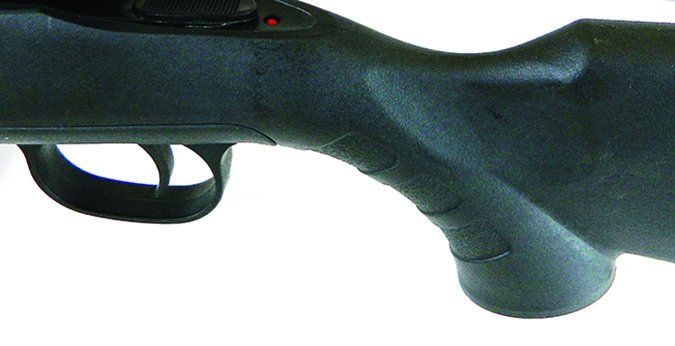
At 50 yards, we slowed down the pace of fire and got solid hits on the metal reaction target. We fired the rifle at 100 yards off hand and saw the results were okay, but it was the least accurate of the rifles tested. The heavy trigger played against us in the 100-yard test.
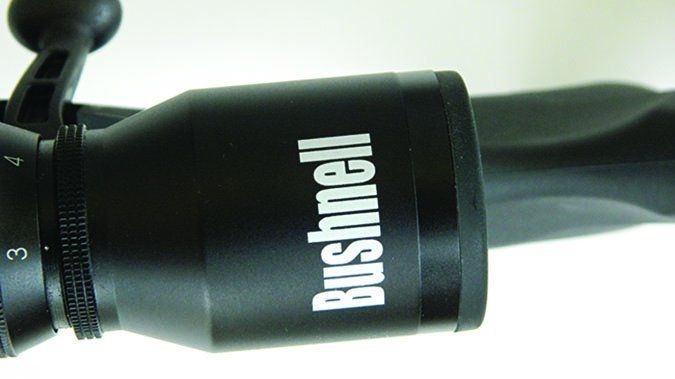
As delivered, the Savage Axis trigger broke at 7 pounds. Most come from the factory at 5 pounds, but the trigger gauge does not lie. Fortunately, one of the raters, who is a regular at the reputable American Gunsmith magazine, was able to do a quick trigger-action modification to bring the break down to 4 pounds. This trigger action on this rifle was heavier as issued than any of the 308, 270, 22-250, and 30-06 Axis rifles we have test fired. Nevertheless, the reworked trigger was crisp and controllable. Had we left the trigger as purchased, it would have likely cost the rifle another full-grade markdown.

Our Team Said: The Savage rifle was the least accurate rifle tested, even with intervention. We would try to find a better-shooting gun by spending a few more dollars.
Remington Model 700 SPS Tactical 85538 308 Winchester, $600
GUN TESTS GRADE: B+
This short rifle isn’t the most accurate rifle, but the overall handling is superb. It is fast into action and while it is heavy, the balance is such that it doesn’t feel heavy. The action is smooth. The barrel is threaded for a muzzle brake or suppressor. The Hogue Overmolded stock is a plus. We like the Remington SPS Tactical, but when we looked at the data, it wasn’t all that accurate, it was heavy, and it produced the least velocity. We think it is a better rifle than the Axis, but it’s also three times the cost of the Savage.

| ACTION TYPE | Bolt, Model 700 |
| OVERALL LENGTH | 36.25 in. |
| BARREL | 16.5 in. blued steel heavy contour; 1:10 twist, 5/8″-24 threaded muzzle |
| OVERALL HEIGHT w/ SCOPE | 7.5 in. |
| LENGTH OF PULL | 13.4 in. |
| WEIGHT UNLOADED | 8.75 lbs. |
| WEIGHT SCOPED (empty) | 10.1 lbs. |
| WEIGHT SCOPED (loaded) | 10.4 lbs. |
| CAPACITY | 4+1; fixed box magazine |
| ACTION | Black oxide-coated steel; drilled and tapped, hinged floorplate magazine |
| STOCK | Hogue Overmolded pillar-bedded; SuperCell recoil pad; semi-beavertail forend |
| TRIGGER PULL WEIGHT | 2.5 lbs., X-Mark Pro externally adjustable trigger |
| WARRANTY | 2 years limited |
| TELEPHONE | (800) 243-9700 |
| WEBSITE | Remington.com |
| MADE IN | USA |
In shooting the Tactical, we especially wanted to see the difference in its performance compared to the longer-barreled SPS rifle. The short-barrel Tactical features a Hogue Overmolded stock, a great addition to a credible rifle. The bolt action is smooth, and while it maneuvers well, the rifle is heavy. At a test weight of 10.3 pounds with scope and fully loaded, it is even heavier than the SPS Varmint rifle. However, the Tactical showed excellent speed to target because of its shorter length. It was the fastest rifle to gain an accurate hit at 50 yards. The Savage was close at 25 yards, but at 50 yards, the heavier Remington, with its smooth action, proved to be a stable firing platform.
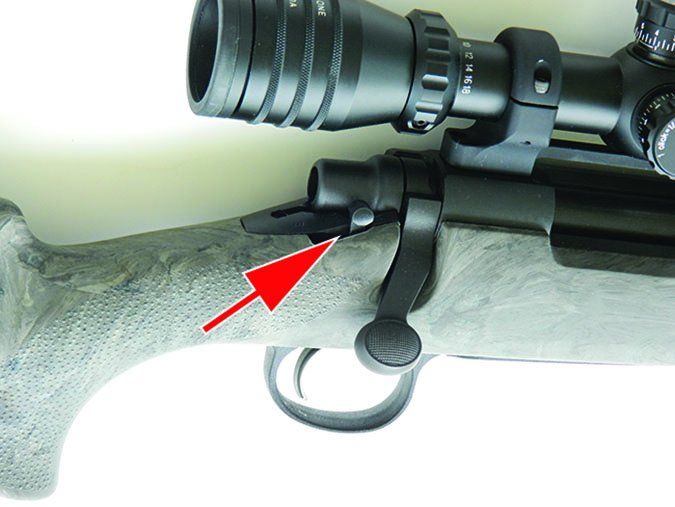
At the 100-yard line firing offhand, the rifle likewise proved to be the most accurate. We feel that the steady feel of the Hogue stock is one reason. The design of the pebbling around the pistol grip and the stock’s superb fit are other reasons the rifle handled so well. Yes, the Remington SPS Tactical rifle is heavy, but the weight is centered between the hands, whereas the long-barrel Varmint has a different balance. In offhand fire, the short SPS really had an advantage.
Fired from a bench, the Remington Tactical delivered mostly second-place accuracy, coming in behind the Varmint with the Gorilla Ammunition 175-grain rounds with a 1.2-inch average group size, again behind just the Varmint with the Hornady ELD Match 168-grain Polymer Tip load at 1.4 inches, and behind the Varmint and the BAR with the Federal Trophy Bonded 165-grain at a 1.9-inch average group.
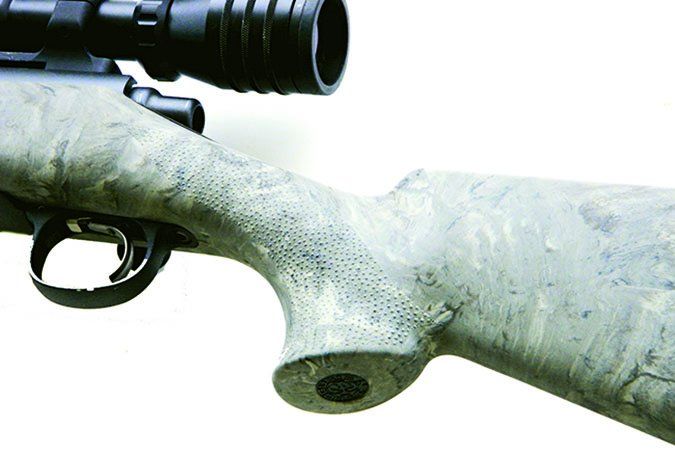
Both the SPS rifles had X-Mark Pro externally adjustable triggers, a feature we like. To adjust the triggers, put the safety mechanism in the Safe position, check the chamber and magazine of the rifle to make sure there are no cartridges in the rifle. Never attempt to adjust the trigger-pull force on a loaded rifle. Then, to adjust the trigger-pull force, place the provided wrench’s hex key in the socket of the adjustment screw. A standard 1⁄16-inch hex key can also be used to make this adjustment. Adjust the trigger-pull force to the desired setting by turning the adjustment screw. Turning the trigger-pull adjustment screw counterclockwise will lighten the trigger pull force. Turning the trigger-pull adjusting screw clockwise will increase the trigger-pull force. Trigger pull will change by approximately 1 pound for each full turn of the adjustment screw. After making an adjustment, remove the wrench from the socket of the adjustment screw. Dry fire the rifle several times after making an adjustment to ensure the trigger pull force spring is reseated. Check the trigger-pull force with a force gauge or deadweight. Repeat the checking step several times to ensure the proper trigger-pull force is maintained.
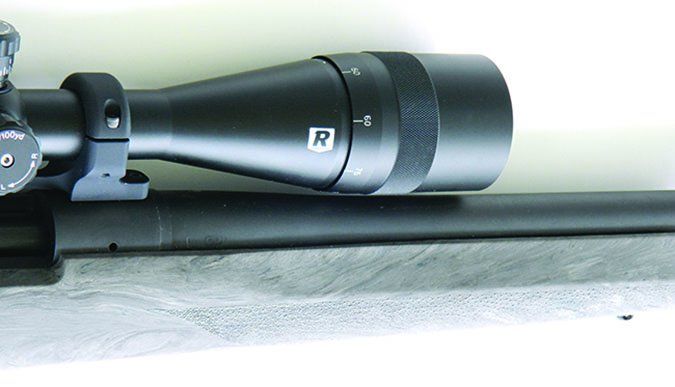
If the proper trigger-pull force cannot be maintained from pull to pull, then return the firearm to the factory for service. Do not use your rifle if the trigger pull force can not be maintained. Also, the minimum achievable trigger pull force is preset at the factory and must not be altered. It’s also wise to note that if you expect at any time to loan or sell your rifle or to use the rifle for anything other than competition target shooting from a secure, stationary rest in a controlled environment, you should readjust the trigger-pull force to at least 3 pounds.
Our Team Said: The Tactical was much more accurate than the Savage across the board, and mostly on par with the BAR, but it was clearly less accurate than the Varmint. The rifle proved to be as fast as the Savage at 25 yards, faster and more accurate at 50 yards, much more accurate at 100 yards off hand, and more accurate than the Savage off the benchrest. It also handled better than its longer-barreled Remington SPS stablemate. While accurate enough for most uses, the short-barrel SPS suffered in accuracy compared to the longer barrel SPS Varmint. Because it already has an expensive muzzle treatment we like, we gave it a half-grade boost to settle at a B grade.
Remington Model 700 SPS Varmint 84218 308 Winchester, $606
GUN TESTS GRADE: B+
The Remington SPS Varmint does exactly what it was designed to do, deliver excellent accuracy. You would be hard pressed to find a production rifle that is capable of greater practical accuracy than the SPS Varmint. There is a trade-off—the rifle is heavy, but not as heavy as the SPS Tactical by a few ounces. The balance is different, however, and the SPS Varmint doesn’t handle as well offhand as the Tactical. Off the bench, it is a joy to fire.

| ACTION TYPE | Bolt, Model 700 |
| OVERALL LENGTH | 46.5 in. |
| BARREL | 26 in. long, matte-blued steel heavy contour |
| OVERALL HEIGHT w/ SCOPE | 7.5 in. |
| LENGTH OF PULL | 13.4 in. |
| WEIGHT UNLOADED | 8.5 lbs. |
| WEIGHT SCOPED (empty) | 10 lbs. |
| WEIGHT SCOPED (loaded) | 10.3 lbs. |
| CAPACITY | 4+1 |
| ACTION | Matte-blued steel; drilled and tapped, hinged floorplate, fixed box magazine |
| STOCK | Matte-black synthetic; SuperCell recoil pad; sling-swivel studs, vented beavertail forend |
| TRIGGER PULL WEIGHT | 2.5 lbs., X-Mark Pro externally adjustable trigger |
| WARRANTY | 2 years limited |
| TELEPHONE | (800) 243-9700 |
| WEBSITE | Remington.com |
| MADE IN | USA |
This is a heavy rifle at 8.5 pounds without a scope, and we were interested to see how the heavier rifle performed, particularly the 26-inch barrel. Scoped, the empty Remington Special Purpose Synthetic Varmint rifle hit 10 pounds, then loaded, it came out to 10.3 pounds ready to go to the field. The barrel is 26 inches, longest of the test. The rifle is heavy and kicked the least of any rifle tested. Remember, recoil force hits the shoulder, and recoil is less with a heavier rifle. The rifle might be heavy to carry, but for a long firing session, we noticed it was a light kicker. The Remington 700 features a synthetic stock that was credible, but nothing as interesting as the Hogue Overmolded on the Tactical rifle. There are three sling swivels, so mounting both a bipod and a sling is possible. Fit was good, but not quite as good as the Savage rifle’s stock-to-action fit, we thought.
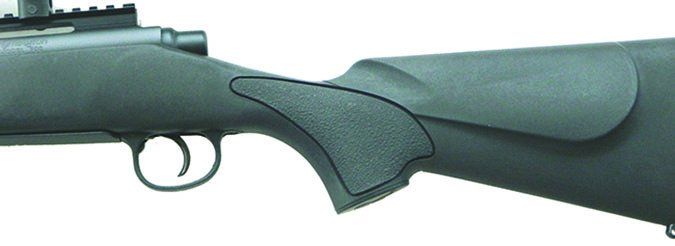
The bolt action is smooth enough, rated the most workable of the test. The safety, mounted on the receiver and pushed forward for fire, was fast and positive in action. The Savage was faster, but the call was close.
This rifle’s long barrel delivered the most energy of any rifle tested. Average velocity advantage over the Savage rifle was a solid 80 to 100 fps. The advantage over the 16.5-inch-barrel Remington 700 SPS Tactical was much greater, from 200 fps to even more. This is significant, and you must decide how important this is for yourself. When firing the SPS Varmint during the acclimation period at 25 yards, we decided it was as fast as the other rifles to a first-shot hit, but it was slower for follow-up shots. The heavier weight resulted in a need to balance the rifle and bring it up for each shot. When you move the firing hand to the bolt, the barrel dips under its own weight. For some shooters, maintaining control of the rifle without the aid of a bipod or rest is challenging. We were pushing the design envelope in short-range speed shooting.
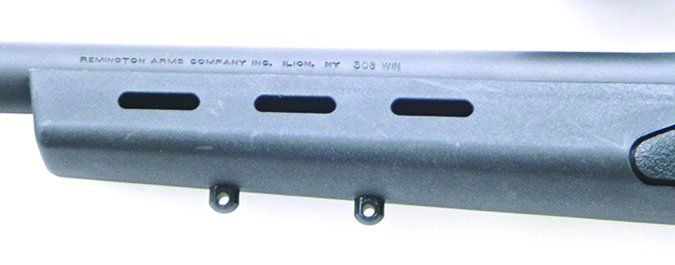
At 50 yards, the weight was appreciated, allowing the rifle to simply hang on the target. The results were good, but not as fast as the other rifles. As a fast-moving rifle for brush hunting or firing at predators off hand, this isn’t the best choice. When the Remington SPS Varmint was fired from the bench, it came into its own.
The Remington 700 SPS Varmint rifle gave one of the best accuracy showings of any 308 Winchester rifle we have tested. At 100 yards, the rifle put three Gorilla Ammunition 175-grain SMKs into a 0.75-inch group on the first try. As noted above, the Varmint dominated the accuracy portion of the test. Its Gorilla Ammunition average was a 0.9 inches, as was its result with the Hornady ELD Match 168-grain Polymer Tip load. With the Federal Trophy Bonded 165-grain Polymer Tip, the Varmint shot 1.0-inch average group sizes. The smallest group was a tight 0.6 inches with the Federal 165-grain Bonded Core.
Our Team Said: The Remington Special Purpose Synthetic Varmint rifle was a joy to fire off the bench. Off hand, it was slower to handle and gave up something inside of 50 yards to the other rifles in speed. Firing off hand in deliberate fire at 100 yards, it gave up nothing and gave good results. The SPS Varmint was by far the most accurate rifle at the 100-yard benchrest and also the most accurate rifle in firing off hand at 100 yards. If short-range handling isn’t a thing for you, then this is clearly an A gun. As it was, we had to knock it down in our overall ranking because it was slow to target, which we recognize as a trade-off for the other excellent performance it delivered.
Browning BAR MK3 Stalker 308 Winchester, $600
GUN TESTS GRADE: B
A great all-round field gun and a rifle that will hold its own in accuracy. Pricey, though. Worth noting: Our rifle did not have a composite stock with shim-adjustable cast and drop-at-comb manipulation available on 2017 models.

| ACTION TYPE | Self-loading short action, gas-piston operation, multi-lug rotary bolt |
| OVERALL LENGTH | 44.25 in. |
| BARREL | 22 in. long, matte-blued steel, Sporter contour; chrome-plated chamber; 1:12 twist, hammer forged |
| OVERALL HEIGHT w/ SCOPE | 6 in. |
| LENGTH OF PULL | 13.25 in. |
| WEIGHT UNLOADED | 6.6 lbs. |
| WEIGHT SCOPED (empty) | 8.2 lbs. |
| WEIGHT SCOPED (loaded) | 8.7 lbs. |
| ACTION | Matte-black aluminum alloy receiver, drilled and tapped; hinged composite floorplate |
| CAPACITY | 4, detachable box |
| MAGAZINE TYPE | Fixed box |
| STOCK | Matte-black composite w/ polymer recoil pad, no pistol grip cap, Overmolded grip panels, integral steel sling swivel studs, QD swivel cups, swivels included |
| TRIGGER PULL WEIGHT | 4 lbs.; gold-plated |
| SAFETY | Crossbolt |
| WARRANTY | None |
| TELEPHONE | (800) 322-4626 |
| WEBSITE | Browning.com |
| MADE IN | Belgium |
After finding a winner among the bolt guns, we decided to compare the winning bolt gun to a popular self-loading rifle. We had to find a well-cared-for used rifle to make the price comparable to our other test guns. The closest current model to our test gun is the 22-inch-barrel No. 031048218, which sells for $1079 at Able’s Sporting Goods and $1100 at BudsGunShop.com.
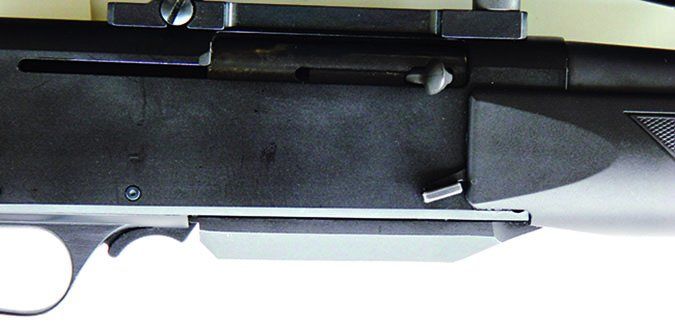
The Browning Automatic Rifle (BAR), introduced in 1967, uses a short-stroke gas system for operation. It has a 20-inch barrel weighing in at 8.2 pounds scoped. The Stalker features a synthetic one-piece stock. The fit of the stock and forend was good. The finish is a matte black that is credibly done. The buttstock has a full pistol grip, and the checkering on the pistol grip aids in getting good adhesion when firing.
Operation is simple enough. The bolt head rotates on seven lugs to engage recesses in the barrel. The lock up is tight. When the rifle is fired, the bolt head rotates on a cam pin in the bolt sleeve or bolt carrier. The extractor is a strong hook type. There is a separate ejector.
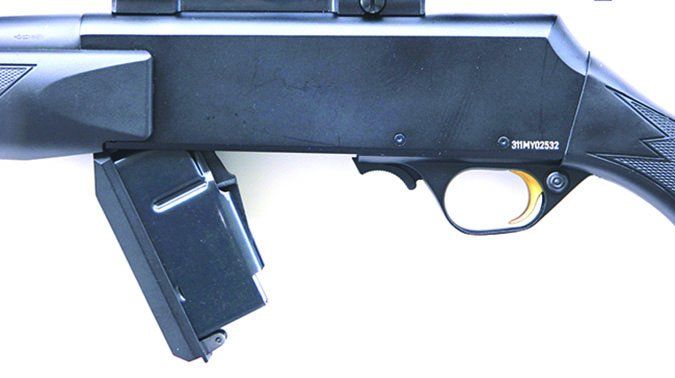
The controls are simple. A bolt release is located at the right front of the receiver. The magazine release is under the receiver. It is fast in operation and offers easy reloading, simply opening the magazine on a hinge. It is rated the fastest of the four rifles tested to load or unload. To make the rifle ready to fire, simply rack the bolt to the rear and release. The bolt holds open on the last shot fired. The safety is a push-button type in the trigger guard. We rated the safety fast and positive in operation.
At the range, we used the same loads used with the bolt-action rifles and the same firing tests. Firing at 25 and 50 yards, the rifle proved more accurate than the Savage Axis or the Remington SPS Varmint rifle when speed and accuracy were demanded. Accuracy was equal to the Remington SPS 16.5-inch barrel, but the BAR’s speed was greater. Firing off hand at the 100-yard line, the Browning BAR Stalker gave an excellent account of itself. The very nice 4-pound trigger helped. The BAR outshot the Savage rifle, and though not as accurate as the Remington rifles in offhand fire at 100 yards, speed for a fast follow-up shot was excellent.
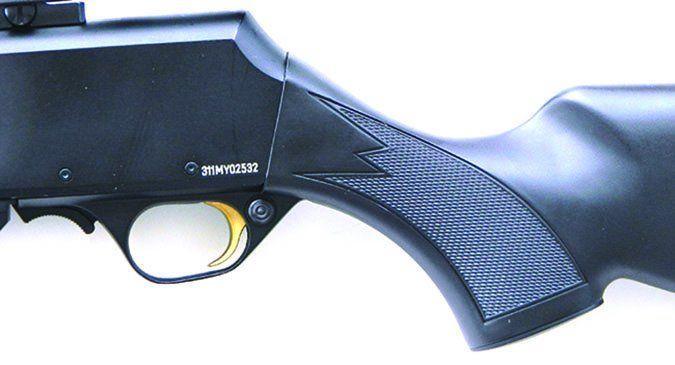
Firing off a solid bench rest to confirm accuracy potential, we had something of a surprise. The Browning BAR Stalker was more accurate than the Savage Axis. When the raters tabulated accuracy results with the rifle after the 100-yard testing, the Browning proved practically as accurate as the shorter-barrel Remington SPS Tactical and was more accurate with the Federal 165-grain loading. In practical accuracy, the BAR doesn’t take a back seat in accuracy to any of the others. It should prove as accurate a field gun as the bolt guns in most field situations, save for the overwhelming accuracy potential of the heavy but accurate Remington SPS Varmint gun at longer range. If handloading is important, the BAR action works brass more, so some loads may not be suitable for the BAR, including very light or very heavy loads. Just the same, with factory loads or standard handloads, the rifle should prove useful and accurate.
Our Team Said: The primary drawback is price. We were lucky to find a used rifle in out-of-the-box condition. A new BAR Stalker is $1050 or higher without sights or a scope, so it is well above the cost for the others as all-round go-anywhere do-anything rifles.
All in, we had no perfect rifle. All were comfortable to fire, although the lightest rifle, the Savage Axis, kicked the most. If the range were to run out to 200 yards, the superior accuracy of the Remington SPS Varmint gun leaves the others coming up short. Just the same, for overall handling and acceptable accuracy, we believe the Remington SPS 16.5-inch barrel rifle is the more useful, go-anywhere do-anything rifle. If you need to sit on a hill and shoot game at 300 yards, the SPS Varmint rifle is the trick. The Browning Stalker is okay in most respects—it comes to target fine and offers faster second shots, but it wasn’t as accurate as we would like and it’s going to be more expensive new. We would prefer to offer an enthusiastic recommendation to give you, but we just didn’t find that kind of performance from this quartet.
Written and photographed by Bob Campbell using evaluations from Gun Tests team testers.



























